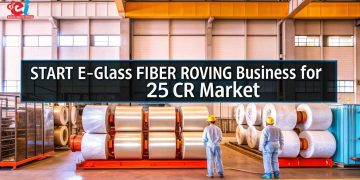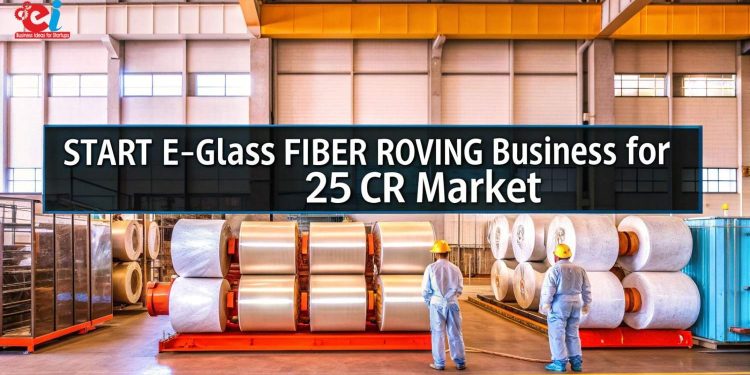As industries shift towards lighter, stronger, and more versatile materials, E-Glass Fiber Roving has positioned itself as an indispensable reinforcement material in modern manufacturing. E-glass fiber roving enables the fabrication of high-performance composites for automotive, aerospace, wind energy, construction, and electronics that surpass traditional materials such as steel and aluminum in strength-to-weight ratio and corrosion resistance.
Amid the global trends of lightweighting, sustainability, and enhanced structural efficiency, E-glass fiber roving has emerged as a preferred material for manufacturers who seek a balance between performance and cost. For Indian entrepreneurs and businesses, investing in the production or application of E-glass fiber roving is not only a technologically sound investment, but also a financially strategic one given the surging demand in the electric vehicle (EV) market, infrastructure undertakings, renewable energy systems, and marine composites.
This article aims to analyze the composition, manufacturing process, applications, benefits, and the business prospects of E-glass fiber roving as a strategic material solution for modern 21st century manufacturing.
What is E-Glass Fiber Roving?
E-glass roving or E-glass (fiber roving) is an electrical grade glass composed of soft alumino borosilicate glass strands splitting into strands of filaments. The non-adding alkali glass is formed through heating. The glass strands’ filaments are bound into a roving without twisting. Automatic Banders, Fiber Winders and Cannon Benders for textile-structure filature-palay are capable of weaving, chopping, or impregnating the materials with resins for further reinforced composites.
Owing to its superb insulation properties of electricity, tensile strength, and thermal stability, E-glass fiber roving is greatly used in other fiberglass reinforced plastics (FRPs). It fills gaps for the strength and acts as a backbone for composite components produced from pultrusion, filament winding, sheet molding, and resin transfer molding.
E-glass filament’s diameter usually varies from 9 to 24 microns and roving types are selected depending on the requirements for tex value (weight per unit length), compatibility with resin sizing (adhesion), and method of processing/style of application.
Composition and Manufacturing Process
The base material of E-glass fiber is composed of a mixture of silica (SiO₂), alumina (Al₂O₃), calcium oxide (CaO), boron oxide (B₂O₃), and other oxides. The raw batch is submitted to melting in a furnace at over 1,400°C. The molten glass is then spun into fine filaments through platinum bushings, which are cooled, sized chemically to enhance resin compatibility, and protect the fibers from abrasion.
The coated filaments are gathered into strands and wound onto hollow cylinders to form roving. Roving may be direct, pre-wound in a single step, or assembled, which means multiple strands combined.
E-glass fiber roving production plants are now equipped with modern automation, making them available for long periods of continuous operations. The quality of the fibers is assured with laser monitors checking diameter, moisture control units, and strategic temperature control of the bushings.
Related: Empowering the Future with a Carbon Fiber Plant in India
Industrial Applications of E-Glass Fiber Roving
E-glass fiber roving is used in various industries because of its mechanical, thermal, and chemical resistance properties. In the automotive industry, it is used for manufacturing body panels, battery boxes, and other components located under the hood because of lightweight ‘structural integrity’ design. This feature enables EVs and hybrids to improve fuel efficiency, driving range, and battery longevity.
In aerospace and defense, E-glass composites are used for interior panels, fairings, and other parts that require lightweight strength, insulation, and flame resistance. In the wind energy sector, the material is crucial for fabricating turbine blades which are needed to have long spans and high tensile strength.
Other countries of major concern include construction and infrastructure. E-glass fiber roving is used for rebar, water tanks, facade panels and bridge components owing to their ability to sustain severe environments and non-corrosive properties. In marine manufacturing, the roving is also used for the boat hulls and panels that have saltwater resistance.
High dielectric strength and thermal stability are other advantages provided by E-glass composites to electronics and appliances subdivisions such as in circuit boards and insulation panels.
Flip the Page Towards Traditional Materials
One of the main drivers of adoption of E-glass fiber roving is the performance-to-cost benefits it provides in comparison with metals and wood. E-glass is lightweight but strong, offering great mechanical performance while sustaining significant weight reduction. This makes it ideal for portable and high-speed products like Modular Building, electric vehicles and even drones.
It also has great corrosion resistance, which is important for coastal infrastructure systems, chemicals tanks and even underground systems. Unlike steel or aluminum which rust and pit, E-glass composites are far better as they don’t corrode structurally in water, chemicals, and even UV radiation.
Since E-glass fiber is non-conductive and non-magnetic, it becomes extremely safe for use under electrical environments. On top of that, E-glass fiber is more easily moldable into complex shapes when compared to metals, which gives a greater sense of design to product engineers.
E-glass composites are also rich eco-friendly as they are durable which reduces maintenance costs over time. Sustainability focused manufacturers will find joy because E-glass composites align with green building standards in construction and eco-design initiatives.
SMEs and Composite Manufacturers Business
The roving E-glass fiber market offers new opportunities for many small and medium enterprises (SMEs). Some of these include:
- Establishment of E-glass roving production units (Has a capital-intensive cost but great demand potential)
- Conversion into woven mats, fabrics or cut strand products
- Custom composite part fabrication (For automotive, marine or construction industries)
- Trade or distribution of E-glass roving products to downstream suppliers
Renewable energy, Smart city initiatives, National electric mobility mission will help develop self-sustained Indian demand. There is also a strong potential for exports to South East Asia, Africa, and Middle East due to the rapid development of their infrastructure and transport industries.
Domestically producing E-glass roving will help mitigate dependency on China’s supply of glass fibers due to the Indian government’s focus on “Make in India”.
Using “Make in India” along with an import substitution strategy, E-glass roving can be produced within the country to support glass fiber demand.
Depending on whether there is full-scale production or value-added processing, an investment of ₹5–₹25 crore with a space of 10,000–20,000 sq ft will be required. However, working alongside skilled Niir Project Consultancy Services (NPCS) can streamline the setup and timeline of the project.
Related: Setting up Own Carbon Fiber Reinforced Polymer Manufacturing Business
Environmental Impact and Recyclability
Although E-glass fiber has a negative impact on nature because it does not decompose, it is considerably less harmful than metals and thermoplastics when used in combination structures. It has a long lifespan, which results in less replacement and material use in the long run. The use of discarded E-glass and bio-resins in hybrid materials is also being investigated by some manufacturers.
The glass manufacturing process itself can integrate recycled glass cullet to reduce energy consumption. New advancements in mechanical and chemical recycling methods enable the E-glass from end-of-life composites to be reclaimed, which creates new avenues for sustainable development.
.How NPCS Can Help You Launch or Expand in the Composites Industry
Whether you plan to produce E-glass fiber roving, set up a downstream composite manufacturing unit, or distribute specialty composite materials, entering this segment requires technical knowledge, planning, and regulatory understanding.
Niir Project Consultancy Services (NPCS) provides:
- Detailed Project Reports (DPRs) for setting up E-glass roving or composite units
- Market research on end-user industries and pricing trends
- Plant layout design and vendor selection
- Financial projections, ROI analysis, and investment proposals
- Regulatory guidance including safety, emissions, and quality certifications
With its deep domain expertise in industrial manufacturing and materials engineering, NPCS ensures your venture is compliant, competitive, and commercially successful.
Conclusion: E-Glass Fiber Roving is the Material of the Future
As industries across the globe look for high-strength, lightweight, and corrosion-resistant alternatives to traditional materials, E-glass fiber roving continues to prove itself as a material of choice. Its adaptability, mechanical performance, and cost-efficiency make it a cornerstone for composite technologies in sectors that are driving the future of mobility, energy, and infrastructure.
For entrepreneurs, manufacturers, and investors, the opportunity to work with E-glass fiber roving—either in production, processing, or end-use applications—is timely and highly scalable. With strong demand indicators, favorable policies, and expert support from partners like Niir Project Consultancy Services, the path to building a future-ready composites business has never been clearer.


























